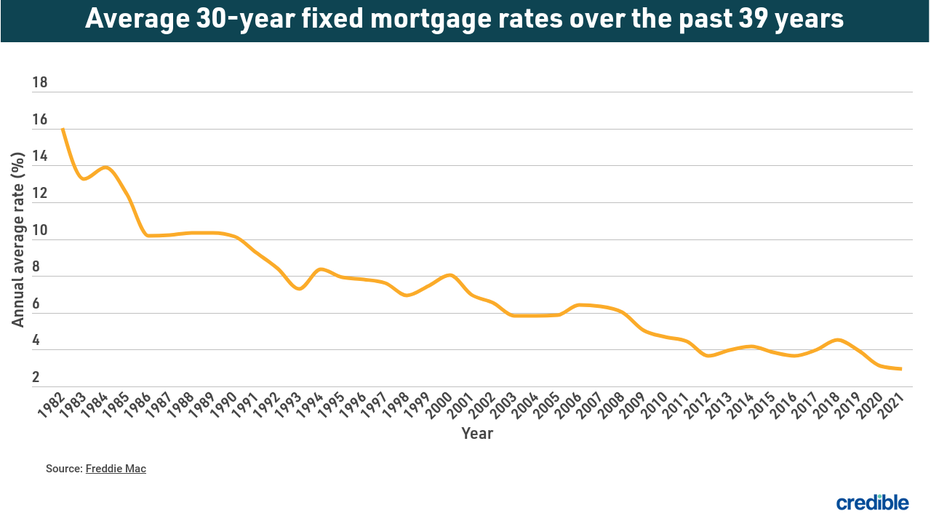Today’s mortgage refinance rates fall across 3 terms | May 20, 2022
20-year rates are on a downward swing for the second straight day, making this term a good bargain for homeowners who want to refinance

Check out the mortgage refinancing rates for May 20, 2022, which are mostly down from yesterday. (Credible)
Based on data compiled by Credible, mortgage refinance rates have fallen across three key terms and remained unchanged for one term since yesterday.
- 30-year fixed-rate refinance: 5.000%, down from 5.250%, -0.250
- 20-year fixed-rate refinance: 4.750%, down from 4.875%, -0.125
- 15-year fixed-rate refinance: 4.375%, down from 4.500%, -0.125
- 10-year fixed-rate refinance: 4.375%, unchanged
Rates last updated on May 20, 2022. These rates are based on the assumptions shown here. Actual rates may vary.
If you’re thinking of doing a cash-out refinance or refinancing your home mortgage to lower your interest rate, consider using Credible. Credible's free online tool will let you compare rates from multiple mortgage lenders. You can see prequalified rates in as little as three minutes.
What this means: After soaring to 5.5% mid-week, rates for a 20-year refinance have been slipping downward for two straight days. Although 30-year rates also fell today — to 5% — at 4.750%, 20-year rates are a quarter of a percentage point lower. This mid-length term will come with a manageable monthly payment while allowing homeowners to save interest over the life of their mortgage. Homeowners who can swing a higher monthly payment might also consider 15- or 10-year terms: Both are sitting at 4.375%.
WHAT IS CASH-OUT REFINANCING AND HOW DOES IT WORK?
How mortgage rates have changed over time
Today’s mortgage interest rates are well below the highest annual average rate recorded by Freddie Mac — 16.63% in 1981. A year before the COVID-19 pandemic upended economies across the world, the average interest rate for a 30-year fixed-rate mortgage for 2019 was 3.94%. The average rate for 2021 was 2.96%, the lowest annual average in 30 years.
The historic drop in interest rates means homeowners who have mortgages from 2019 and older could potentially realize significant interest savings by refinancing with one of today’s lower interest rates.

If you’re ready to take advantage of current mortgage refinance rates that are below average historical lows, you can use Credible to check rates from multiple lenders.
How to get your lowest mortgage refinance rate
If you’re interested in refinancing your mortgage, improving your credit score and paying down any other debt could secure you a lower rate. It’s also a good idea to compare rates from different lenders if you're hoping to refinance so you can find the best rate for your situation.
Borrowers can save $1,500 on average over the life of their loan by shopping for just one additional rate quote, and an average of $3,000 by comparing five rate quotes, according to research from Freddie Mac.
Be sure to shop around and compare current mortgage rates from multiple mortgage lenders if you decide to refinance your mortgage. You can do this easily with Credible’s free online tool and see your prequalified rates in only three minutes.
How does Credible calculate refinance rates?
Changing economic conditions, central bank policy decisions, investor sentiment and other factors influence the movement of mortgage refinance rates. Credible average mortgage refinance rates reported in this article are calculated based on information provided by partner lenders who pay compensation to Credible.
The rates assume a borrower has a 740 credit score and is borrowing a conventional loan for a single-family home that will be their primary residence. The rates also assume no (or very low) discount points and a down payment of 20%.
Credible mortgage refinance rates reported here will only give you an idea of current average rates. The rate you receive can vary based on a number of factors.
Think it might be the right time to refinance? Be sure to shop around and compare rates with multiple mortgage lenders. You can do this easily with Credible and see your prequalified rates in only three minutes.
Can you refinance a jumbo loan?
A jumbo loan is also called a non-conforming loan since it doesn’t conform to the loan limits established by Fannie Mae and Freddie Mac. For 2021, that’s $548,250 for a single-family home. Jumbo loan rates are typically higher than refinances for conforming loans.
It is possible to refinance a jumbo loan, but you’ll likely have to meet higher qualification standards than you would to refinance a conventional loan. Requirements may include:
- A good to excellent credit score and clean credit history
- A debt-to-income ratio much lower than ones required for conventional loans
- Six months to a year of cash reserves
You may need to provide extra documentation to verify your income and overall financial situation. And, as with any refinance, you’ll have to pay closing costs, which can be significantly higher for a jumbo loan.
Have a finance-related question, but don't know who to ask? Email The Credible Money Expert at moneyexpert@credible.com and your question might be answered by Credible in our Money Expert column.
As a Credible authority on mortgages and personal finance, Chris Jennings has covered topics that include mortgage loans, mortgage refinancing, and more. He’s been an editor and editorial assistant in the online personal finance space for four years. His work has been featured by MSN, AOL, Yahoo Finance, and more.
